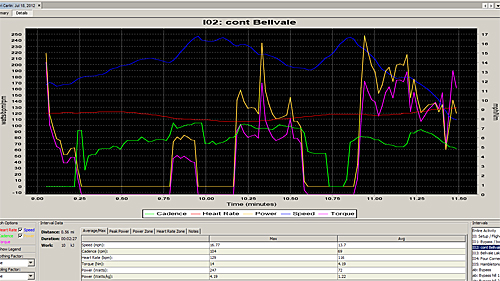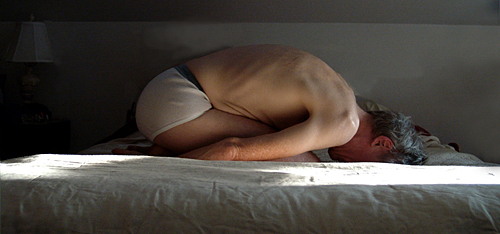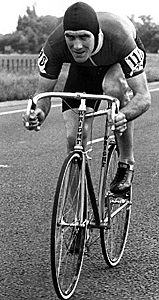Updated
January 22, 2016
| By Bob Fugett
Myth of the Cycling Dead Spot
<--
prev |
next -->
| Torque:
--- Watts:
--- Speed:
--- Heart Rate:
---
Cadence: --- |

Example of perceived effort on downhill actually equaling zero watts
Click for
Full Image It was Flori's first on-bicycle power meter lesson and I shuddered
thinking the meter must be broken.
I was sitting on
her wheel watching her performance using my wireless CPU.
She was obviously working the downhill with a moderate cadence, but her
readout showed zero watts, absolutely none, no power at all.
She certainly was not spun out, so I guessed maybe she only appeared to be
pushing with force but really was only turning the cranks over lightly (a tactical
maneuver used to trick an opponent into overworking). I asked about it. Her reply, "Yes, I noticed it
also. I was working, but the power meter showed nothing. What was that about?"
I thought a minute, watched it happening again and again for another couple
miles, then breathed deep. "That's it! I think I know what's happening. I bet
this is why a lot of people are mystified when I tell them they could go
easier uphill, work the downhills a little, and still be a lot faster—despite working less and feeling better at the end—that a 20
mph pace takes less force on the pedals than is required to pick a full cycling
water bottle off the floor and place it on a table." To
check my theory about her lack of power I tested Flori on
Spun Crystals as soon
as we got to a flat
section that was long enough to get results.
I make use of Spun Crystals during my Flightcheck before every ride to confirm my
functionality and decide how I should handle each workout.
If things are not right, I alter my ride to make them right again.
Sure enough when Flori tried the Crystals she could not pull either leg over
the top of her cranks effectively.
What she perceived as "working" on the downhill was merely one leg fighting
against the other to get it over the top of her stroke.
I have shown Crystals to a bunch of people and every one of them
was shocked that one of their legs did not want to come over the top.
However, here we had an instance of neither leg having full range of motion.
Without the power meter I would never have noticed, because I just saw her
working and assumed she was generating power.
Reminded me that a few years ago I did an extended search looking for more
information about the cycling Dead Spot only to realize it was a
myth that evaporated on close inspection.
I could not find one article that gave a cogent explanation of just where the
supposed dead spot is (12 o'clock or 6 o'clock) nor why it would necessarily exist based on human anatomy.
Maybe you could convince me of a Weaker Spot but certainly not a Dead Spot, so I put together some exercises to get rid of it in myself and
fixed it both top and bottom.
Having done that I knew enough about the situation to caution Flori when she
immediately tried to fix her own problem after I pointed it out.
"This is not something you can fix while on your bicycle. You have to do floor
exercises to get your basic movement correct first. Remember: your bicycle is an
amplifier. It amplifies your power and your speed, but it also amplifies your
dysfunction. This is no quick fix."
It is also easy to fool yourself using only a single dysfunctional leg
if under some forward pressure, because the crank arm acts as a ramp to help you over the
top.
You have to test with absolutely no pressure on the pedal (as if your chain
were dropped) feeling just for
the edge of the circle.
Can you easily hold either leg independently at any point on the circle?
Now can you hold it there with just the slightest forward pressure?
Did you test every one of the 360 degrees for each leg?
Did you then test each position with both legs at the same time?
Can you guess how long it has been since anybody has been able to challenge
me on a hill?
I sent Flori to the videos page for a
rundown on what she has to do to get right.
I also explained how spin cycles with flywheels not only hide the truth about
your power output, they also promote dysfunction by pushing your leg over the
top.
Ironically, her response to that was to mention a method used to negate the
flywheel push which would actually increase the harmful effects... I wouldn't be
surprised to find that method is commonly taught in spin classes.
The next day Flori sent e-mail mentioning she was still confused about the
zero watts, so I looked at the data downloads and confirmed she was spinning
around 75 rpm during the outages so could easily feel she was working the
downhill but actually only regained power when she moved onto the following uphill
and responded
to the hill catching her.
You can see it on the
graph.
What is not apparent from the graph is the fact that exactly the same amount of
effort (with no power generated) is also being wasted on the uphills.
Except on the uphills the zero sum watts portion of her spin is masked by the
extra effort required by the climb.
Flori is wasting the exact same amount of effort on the uphills that she
feels when she is "working" the downhills but has zero watts output.
I see group rides doing it all the time: everybody overworks the uphill,
toasted at the top they are extra dysfunctional on the downhill, so even those
riders who are
catching them on the downhill (even if similar or less body weight) do not need to be
working at that point...not at all!
No wonder the fact a quick light smooth steady spin is inherently more
powerful and generates a faster
speed than a hard mashing stomp remains
a mystery to many riders.
Unfortunately, until the development of on bicycle power meters reaches the
level that both right and left leg have a separate measurement, and added to
that not only is the forward pressure measured (as currently all meters do) but
also back pressure on the pedal (as no meter does), I cannot give an exact figure for
the amount of effort Flori is wasting.
However, her reporting that she is "working the downhill" points to the fact
that it is a significant amount of wasted effort.
When power meters get better, I will be able to say definitively something
like, "See, Flori, you are pushing down hard on the right pedal, but look at the
back pressure on your left pedal, you are holding back even more. If you were
not on a downhill you would actually be going backwards. Do you suppose hills
have to be so hard?"
Without my power meter I could not have seen the problem: that she was
applying force to the pedals but the force was not making it to the wheel.
Without the Spun Crystals I might not have been able to identify the source of
the problem: what a great on bicycle functional movement check.
And without the data downloads I could not have confirmed the facts afterwards:
really nice to have a precise objective window on the past.
I only wish power meters gave both legs independently, showed back pressure,
and sampled fast enough to give instantaneous readings of both Torque and Watts,
so I could talk somebody through this during a ride.
In the meantime I can use Spun Crystals.
Flori's experience has helped me focus on the same thing happening to me in my own
rides, so I've started calling it Florination, as in, "I went too
hard and totally Florinated myself."
The secret to effective power uphill is developing effective power downhill.
By the way, if you cannot do this (see photo below):

Bob working on his aero position while assiduously
not
stretching.
What makes you think you can do this effectively? (see photo below):

Click for image source.
Now go look at those videos.
Note: At the time of Flori's lesson she was Programs Coordinator for the Westchester Cycling Club, a 59 year old
triathlete, spin instructor, and just recovering
from a broken leg. I showed her right at the start of the lesson how even a not young woman
(barely 4
months after a broken tibia stabilized with a titanium rod) can easily spin 425 watts
using an almost imperceptible amount of effort... and as it turns out despite significant dysfunction
in both hips.
<--
prev |
next -->
|